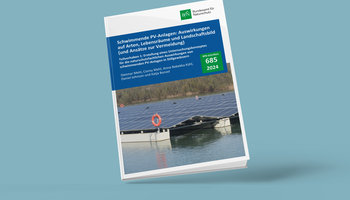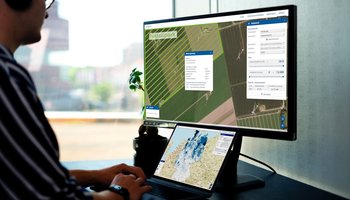Underground cables as an alternative to overhead transmission lines are increasingly under discussion. The project examines the effects of different extra-high voltage underground cable systems on nature and the landscape and provides guidelines on designing underground cable routes in an environmentally sustainable manner.
Experience with the construction of extra-high voltage underground cable routes in Germany is still limited. The research project aims to refine the state of knowledge about various extra-high voltage underground cable systems, their determining factors and their impacts on nature and landscape. The state of knowledge was established by evaluating the specialist literature and relevant project documentation from Germany and elsewhere. In addition, experience was evaluated from the construction phase of the extra-high voltage underground cables that have already been laid. The relevance of operational heat emissions for planning and approval was evaluated, based on the results of simulation and test installations. No monitoring has yet been done in actual operation.
The project also looked at the construction of underground cable routes in open ground, woodland and areas close to settlements. Planting underground cable routes with woody species is limited due to safety regulations, which restricts development potential for conservation, particularly for routes across woodland. We therefore investigated the question of what options there might be for a power corridor planted with woody species that was still in line with the technical safety requirements.
In order to establish the state of knowledge and practice for EHV underground cables, the relevant current scientific literature and planning and approval documentation from completed or currently planned EHV projects in Germany and selected neighbouring countries (NL, DK, BE, GB, CH) were evaluated. The project documentation was assessed in terms of technical requirements and execution, the impacts judged to be relevant and the route design. The evaluation was complemented by interviews and information obtained by telephone or e-mail. Site visits were made to three HVAC projects (Raesfeld, Randstad-Zuidring, Vejle Ådal). This gave rise to a broad knowledge base and a network of contacts in nature conservation.
EHV underground cable projects were identified from an Internet search and by interviewing transmission network operators, and checked in terms of their transferability to the situation in Germany. Project profiles were used to record project data and dimensions, technical design and construction method as well as contacts and project documentation. This also created the basis for a future cross-border knowledge exchange.
The state of knowledge about determining factors and potential impacts was refined on the basis of the technical literature, by evaluating planning and approval documents and from construction reports. One focus was related to the question of what information is available so far on the occurrence of heat emissions and their impacts on the soil (warming), the water regime (drying out) and on soil life, and what relevance is attached to these effects in planning practice. The degree to which practical knowledge from other pipeline projects (natural gas, district heating) can be transferred was also checked.
One focus was on investigating the requirements for the environmentally compatible design with woody species in the case of routes across forests. Various options were developed for an environmentally compatible construction using woody species while maintaining the safety requirements in the buffer strip.
In order to answer these questions, the state of knowledge about the behaviour and depth of the roots of various native species of trees and shrubs was collated. This enabled recommendations for the future use of woody species on cable routes.
The environmental impacts of alternating and direct current projects are essentially the same. Impacts from construction are the main cause of the environmental effects of underground cables. These can be reduced or avoided by an ecological management of the construction. The temperature changes on the surface of the ground due to heat emissions from the cable are within the natural range of variation, according to the current information. As the underground cable technology at the extra-high voltage level is still in the development and test stage, not all the boundary conditions for a final evaluation are currently clear.
Crossing obstacles that cannot be avoided such as streets, running waters or canals can be done by drilling and compacting beneath the obstacle. For longer sections a micro tunnelling process can be considered as a trenchless construction method. These measures can also be used to avoid environmental impacts.
The safety and access requirements of the network operator must be borne in mind when using or planting the route after construction is complete, in particular in the buffer zone (cable trench + safety distances) (no deep-rooting woody species > 1 m root depth). There are fewer restrictions for the rest of the cable route. Native forest trees are therefore not suitable for planting in the buffer zone. The damaging effects of woody species are based mainly on assumptions and conclusion by analogy. There is a need for research in this area in order to confirm or refute these assumptions.
An environmentally compatible construction design can also be achieved even while excluding plants with deep lignifying roots. This requires the establishment of an environmentally compatible route management. The integration of route management in supra-regional interlinked biotope systems only appears to be possible in a few isolated cases.
The environmental impact and the need for an ecological route management are evaluated differently in different European countries. An exchange of views on evaluation criteria and implementation standards would be worthwhile.
Environmental Action Germany (DUH)
Dr. Peter Ahmels
Judith Grünert; Ole Brandmeyer
Hackescher Markt 4
10178 Berlin
Institut für nachhaltige Energie- und Ressourcennutzung (INER)
Hochwildpfad 47
14169 Berlin
Dr. Elke Bruns
Federal Agency for Nature Conservation (BfN)
FG II 4.3 Nature conservation and renewable energies
Alte Messe 6, 04103 Leipzig
Friedhelm Igel
Tel.: +49 341 30977 165
Friedhelm.Igel(at)BfN.de
03.04.2024
Weiter

03.04.2024
Weiter

15.02.2023
Weiter
